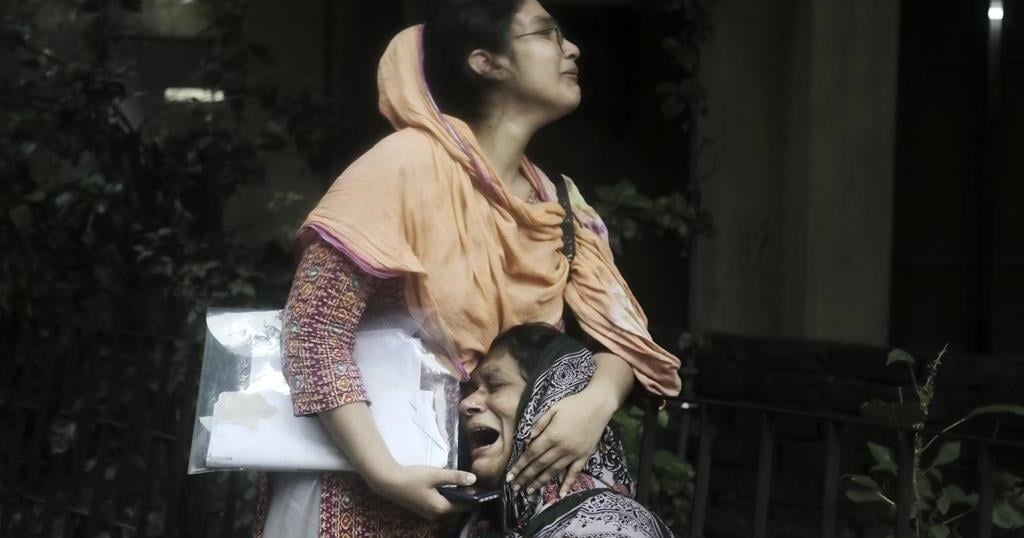DHAKA, Bangladesh (AP) — Bangladesh was crawling back to normalcy with limited internet and office hours Wednesday after more than a week of chaos over student protests involving government job quotas. Nearly 200 deaths were reported in just over a week of violence.
Most of the country remained without internet, but thousands of cars were on the streets of the capital after authorities relaxed a curfew for seven hours.
Offices and banks opened for a few hours Wednesday while authorities restored broadband internet in some areas in Dhaka and the second-largest city of Chattogram. Authorities said the curfew would continue in Dhaka and elsewhere until the situation improves.
Since July 16, at least 197 people have been killed in violence, the leading Bengali-language Prothom Alo daily reported Wednesday. The Associated Press could not confirm the death toll from any official sources.
Schools and other educational institutions have remained shut until further notice.
Clashes have occurred since July 15 between the police and mainly student protesters demanding an end to a quota that reserved 30% of government jobs for relatives of veterans who fought in Bangladesh’s war of independence in 1971. The chaos became deadly after the country’s main opposition Bangladesh Nationalist Party and right wing Jamaat-e-Islami party extended their support to the protests. While violence spread across the country, many government establishments were also under attack in Dhaka.
On Sunday, the Supreme Court ordered that 1971 war veterans’ quota to be cut to 5%. Thus, 93% of civil service jobs will be merit-based while the remaining 2% reserved for members of ethnic minorities as well as transgender and disabled people.
On Tuesday, the government issued a circular, accepting a Supreme Court verdict that reformed the quota system for the government jobs. The government of Prime Minister Sheikh Hasina welcomed the verdict and said it was ready to implement the verdict.
The protesters took time to respond to Sunday’s verdict, and on Tuesday they said that the Supreme Court verdict and the subsequent government circular were in favor of the protesters, but the government should answer for the bloodshed and deaths involving the protests.
The protests have posed the most serious challenge to Bangladesh’s government since Hasina won a fourth consecutive term in January elections that the main opposition groups boycotted. Universities have been closed, the internet has been shut off and the government has ordered people to stay at home.
Protesters had argued the quota system was discriminatory and benefited supporters of Hasina, whose Awami League party led the independence movement, and wanted it replaced by a merit-based system. Hasina has defended the quota system, saying that veterans who fought, who died and the women who were raped and tortured in 1971 deserve the highest respect regardless of political affiliation.
The Awami League and the BNP have often accused each other of fueling political chaos and violence, most recently ahead of the country’s national election, which was marred by a crackdown on several opposition figures.
On Wednesday, the government relaxed the curfew from 10 a.m. to 5 p.m. and opened offices and banks from 11 a.m. to 3 p.m. while garment factories that export mainly to Western countries also opened. Some major roads in Dhaka were clogged with traffic.
Law Minister Anisul Huq has repeatedly said that the violence became grave as the armed cadres of the opposition Bangladesh Nationalist Party and right wing Jamaat-e-Islami joined the protests and attacked many government installations including the headquarters of the state-run Bangladesh Television, two toll plazas of a flyover and an expressway, two stations of metro rail in Dhaka. Hundreds government-owned vehicles were also torched.
The headquarters of the main opposition party was raided and sealed off. Police said they recovered sticks and iron rods and locally made weapons from the opposition party’s headquarters in Dhaka.
Bu Mirza Fakhrul Islam Alamgir, secretary-general of the main opposition, rejected the allegations and blamed the government for the huge number of deaths.
On Tuesday night, authorities restored only broadband internet service partially in Dhaka and Chattogram after six days, said Zunaid Ahmed Palak, junior minister for Information Communication Technology.
He blamed the protesters, calling them miscreants, for the days of internet outage as a main data center was set on fire and fiber optic connections were cut. He said the internet would gradually be restored across the country, but for now corporate businesses, banks, diplomatic zones and some other areas would get internet.
This comes after a curfew with a shoot-on-sight order was installed days earlier and military personnel could be seen patrolling the capital and other areas. Authorities said about 27,000 soldiers were deployed across the country to assist in the civil administration maintain law and order.
Hasina has been holding a series of meetings with the chiefs of the three wings of the military, top business leaders and political partners when she said the curfew was imposed to restore normalcy. She also blamed the opposition for the violence and said the perpetrators would not be spared.
The U.S. Embassy had described the situation Sunday as volatile and unpredictable, adding that guns, tear gas and other weapons have been used in the vicinity of the embassy. They urged Americans to be vigilant, avoid large crowds and reconsider travel plans.
